R2AK: Slow but racier
Published on June 20th, 2018
(June 20, 2018; Day 4) – Did you know there is such a thing as competitive Tai Chi? That thing you did in college and/or during yard time at the Senior Center, that slow-mo martial art that is scientifically proven to be three times more likely to be in a heart medication commercial than your day to day—they’ve got competitions for that.
We’ve got no idea how that actually works, but based on projected ticket sales and its non-presence in our social media feed, we’ve got to think it’s more than a lot like the thrill of placing bets on which paint dries fastest, the January molasses invitational, and so much of the so far in this year’s Race to Alaska.
It’s been great racing, but damn if a three-day stretch of rowing/pedaling isn’t at least a little like seeing which G-ma from the B wing can thug up and “make hands like clouds” slower and better than the rest of them. It’s for sure a race, but everyone from the racer’s blisters to the rest of us would love it if the wind could fill the eff in and the edge could give the rest of the seat the day off for a change.
To be fair, the wind hasn’t been absent as much as it’s phoning it in, giving racers and fans alike the deadbeat-dad bare minimum; gone for days and then showing up for makeup sex and an out-of-nowhere hero run to R2AK Disneyland. From a glassed-off, flat-calm non-response since the race started, to the 15-knot spinnaker run that ushered the trailing fleet within striking distance of the leaders, the wind made a conjugal visit to the front half of the fleet.
Rising from behind and consummating a downwind run that started low and lifted the mid-fleet hopeful from nowhere near to a ‘don’t stop, don’t stop, almost…there’ romp into the gap at Seymour Narrows that peaked to near ‘Hallelujah’ right around noon yesterday. Sky rockets in flight… all that.
The top five teams made it through the gate on the first tide and are already punching into the post-Johnstone, free-range reality. Factoid: that’s a day later and four teams more than any years past. R2AK has tended to have the runaway-train lead team that uses the Narrows like a blocking fullback to pile on the miles while the trailing teams spend a tide or two picking grass out of their facemask.
This year the one and two teams of the Seymour moment – First Federal’s Team Sail Like A Girl (Melges 32) and Team Ptarmigan (F-28 trimaran) swapped leads twice on the approach, with three more nipping at their heels before the water went from favorable to Sisyphus. This year might be slower, but it’s race-ier by far.
The First Federales on Team Sail Like a Girl worked a pedal plus sail past Seymour’s entrance and into the infinite wilderness beyond. They were pedaling, popping the chute, striking it, setting it again, working the fickle wind and rising strength of the tidal river that can take you from sailing downwind to no apparent wind and an accidental jibe in no time flat.
The 5 knots of wind that filled their spinnaker on the approach were still there but evaporated in effect once the current built to 4, then 5, then 6 knots in the same direction within 30 minutes of theoretical slack.
Once your boat gets moving on a current that is in the same direction and anywhere near the speed of the actual wind, the apparent wind that drives your sail drops to zero, and your sails don’t know what to do other than go limp. The ladies rocked it right and “motor” sailed one tack in front of, and then behind, and then ahead again of the hard-charging, father/daughter-plus-a-couple, trimaran team of Team Ptarmigan.
A few minutes later PT Watercraft (Gougeon 32 catamaran) sailed the Narrows flawlessly enough to outpace them both before calling it a day. Next through was the Olsen 30 sailing Aussies of Team Lagopus, smiling as they rowed and flew the chute as the current raced the dying afternoon wind.
Less than an hour behind the leader was the come-from-behind and appropriately named Team Wild Card, sailing the hell out of the SC-27 they bought off of Craigslist a few months back.
All of the teams did, but Team Wild Card especially earned their trip through the Narrows. On the second full night of the R2AK, there were a dozen teams back that decided to double down on a hunch that there’d be wind on the north side of Texada—a winger move that added miles on the bet they could find wind in the valley and do better than everyone else suffering the calms in the central part of the Strait of Georgia.
Talking to people who know better, they would be right as often as wrong on that wager, but this time the coin landed the right way, and Team Wild Card shot from a footnote in the race to an honest-to-god contender for the whole thing. At the time of writing, Team Wild Card slept for a tidal cycle, then woke up to close and then outpace and tack on five miles between them and Team Sail Like A Girl’s all-night bid to hang on to pole position in the oddly light airs of Johnstone Strait.
Team PT Watercraft is still sleeping between the hulls of the G32, but if today is anything like yesterday, Russell’s “Hare, but smarter”/“sail like hell, then sleep” solo-sailor strategy will have him catching up to the leaders by 2 pm or so, when tide and fatigue outpace his coffee consumption, and he has to pull over to deal with either/all of those issues. (Yesterday was a two-thermos day, the day before, three.)
Looking astern, the next wave of seven teams that caught the overnight current train through Seymour is led by the teenaged crew of Team BlueFlash (J/88) who took a nap, took the Narrows, and settled in to nap number two just an island over from PT Watercraft.
The rest of the fleet is plugging along. Another seven are poised to punch through the narrows on the morning tide. Farther back the teams are thinning as the race’s sweaty grind starts to take its toll on the psyche, gear, and the repetitive motion body parts:
Looking forward, the race for the podium is as fresh as it was when we hit the go button on June 17; four teams (three monohulls!) are within sight of the lead as they exit the bizarrely benign Johnstone Strait into the bizarrely benign Queen Charlotte Sound. A year ago it blew 50 when the pack went through Johnstone; today it’s 5-10 with a chance of sunburn. It’s like we blew our wind budget on the hammer-down conditions of the last three years, and we have to eat ketchup soup and leftovers until the check clears at the end of the month. Time to tighten our belts, set the drifter, and row to the next puff.
More tomorrow, R2AK out.
Race details – Team list – Tracker – Facebook – Instagram
Bits and Pieces:
Repaired:
Team TRAK Kayaks bounced off of a rock in False Narrows and put a hole in the fabric of his folding kayak. Sitting in a slowly growing puddle of water he called TRAK Customer Service who told him to just bring it into his nearest dealership—which just so happenened to be two miles away at Qualicum Beach. Repair affected and Team TRAK is back with the pack of human-powered boats, and a few miles back from Team Torrent… who is only a couple of hours behind the pace of Karl Kruger’s record-setting SUP time in 2017.
No Mas:
• Team Mknotkrazee retired after concluding what everyone else already knew: that the best way to sail a Nacra Inter 20 to Alaska is theoretically.
• There was a disappointed and sympathetic sigh at Race Command when Matt Johnson called in to let us know that tendon issues in his knee were forcing an early exit for Team Take Me to the Volcano at Nanaimo. Matt has been in every R2AK, twice in successful bids for Stage 1, and now twice partway to Ketchikan. Judgment called to call it a day before things got out of hand. Last time it was his boat; this time it was his knee.
“I didn’t have time to train the way I wanted. I made a choice to rebuild the boat, and I just ran out of time.” The boat was killer. A low-profile outriggered capsule that surrounded his pro-cyclist leg engine, watching him motor along was more than a little unsettling; his legs and body hidden in the hull, the propeller was spun unseen under the water; to the observer the boat moved with absolutely no visual clue as to why. Matt could hit speeds over seven, led the fleet for the first 24 hours, and tendon issues mean that his Ketchikan glory is at least a year away.
• Closing out the day was Team Dock Rat who, from the looks of the photo, was close to home and was tired of using his dinghy to get to shore. After 48 fatigued hours of pulling his house with a rowboat, Jim’s boat fetched up and went dry on a sandy bit on the west side of San Juan Island. Jim’s Haida 26 will shrug it off and float again; he sounded in good spirits, but how could you not be weighing the cost of shipping your motor back from Alaska with the fact that after two days you’re aground, a shy 20 miles into the race, and a short cab ride from home base. We’re as stubborn as the next guy, but throw in a muffin, and we know which way we’d fall on that decision.
Background:
Race to Alaska, now in its 4th year, began with 47 teams signing up for the adventure of a lifetime. No motor, no support, through wild frontier, navigating by sail or peddle/paddle (but at some point both) the 750 cold water miles from Port Townsend, Washington to Ketchikan, Alaska.
To save people from themselves, and possibly fulfill event insurance coverage requirements, the distance is divided into two stages. Anyone that completes the 40-mile crossing from Port Townsend to Victoria, BC can pass Go and proceed. Those that fail Stage 1 go to R2AK Jail. Their race is done.
Thirty-nine conquered the first test on June 14, of which 31 lined up on June 17 for the start of Stage 2 from the southern tip of Vancouver Island. Other than two waypoints along the way, Seymour Narrows and Bella Bella, there is no official course. Race details.
Source: R2AK


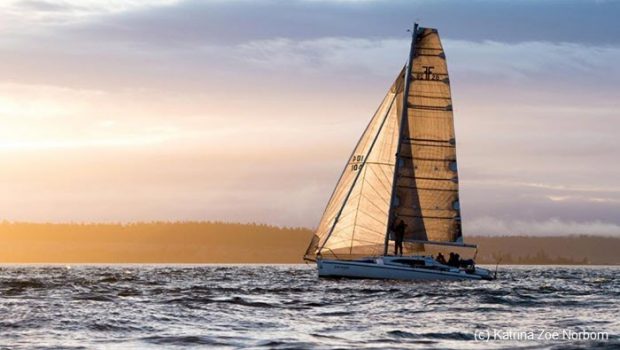

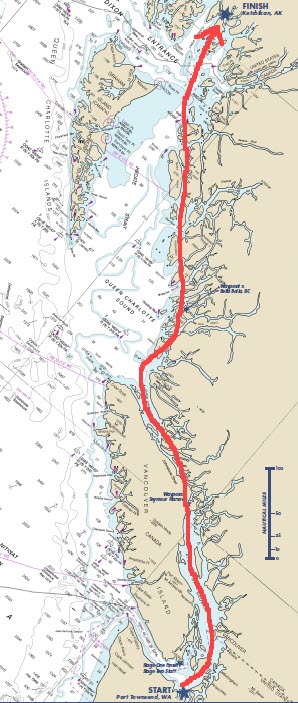

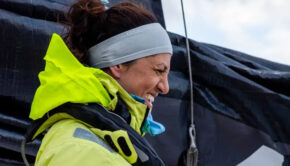
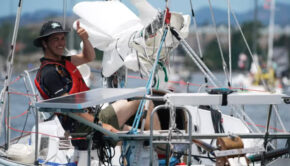
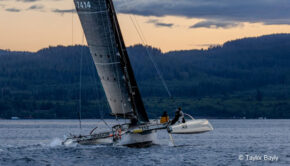
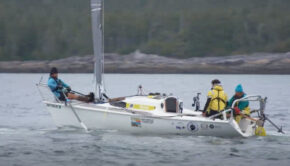
 We’ll keep your information safe.
We’ll keep your information safe.